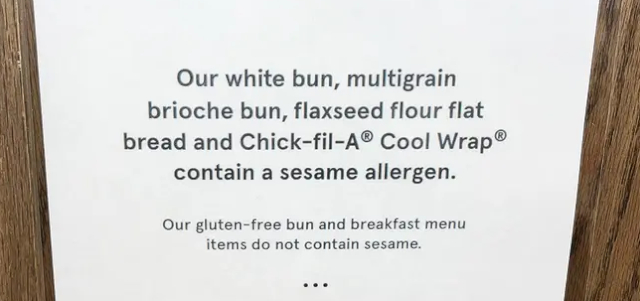We’re all used to seeing labels warning of the possible presence of known allergens. The idea is to warn consumers at risk that the manufacturer can’t guarantee its products are allergen free…
 No question as to where Chick-Fil-A stands on sesame products.
No question as to where Chick-Fil-A stands on sesame products.
Spotted on a door at a NYC Chick-Fil-A, recently.
In fact, there are already laws governing and even mandating the use of allergen warning labels, just to keep all players on a level field. And to protect consumers, of course. But now some food packagers and processors are purposely adding Sesame to their products and clearly warning people of that on their labels.
The previous expensive and inconclusive practice of pussyfooting around, warning that certain products ‘may have been in contact’ with allergens during the manufacturing process, was making some manufacturers crazy. Sesame is one of the harder ingredients to detect in processed foods. Dangerous amounts – even small but significant traces – can migrate into foods that are supposed to be sesame-clear from processing equipment that hasn’t undergone strenuous cleaning and sanitizing between batches.
Complying with FASTER
The the Food Allergy Safety, Treatment, Education, and Research Act (FASTER), was signed into law on April 23 without much fanfare.
Now, some brands are adding sesame on purpose to products that didn’t previously contain it. And labelling their products to clearly inform folks of that. The idea is to clear up any uncertainty about the presence of the allergen. The issue is now clearly in consumers’ hands. “Yah. You have to assume there’s Sesame in this. Definitely,” the brands are saying. “Don’t say we didn’t give you clear warning.” With an implied, “Now, let’s move on…”
But won’t brands lose business and customer loyalty and name prestige using the new compliance method? My guess is that even the 9th largest allergen in the U.S. is costing food processors more than it’s worth in market share to comply with the regulations. So the creative solution is to take a small hit in image and sales, and get on with building other Brands
Nevertheless, fans are furious
Jason Linde, the senior vice president of government and community affairs for FARE, a nonprofit working to increase food allergy awareness, has picked up the torch for sesame allergy sufferers everywhere.
“On behalf of the more than 32 million Americans with life-threatening food allergies and the approximately 1.6 million Americans allergic to sesame, we are disappointed and frustrated that previously trusted companies would rather add small amounts of sesame flour to their bakery products than comply with the intent of the FASTER Act, clean their lines, and safely feed members of our community,” Linde wrote in an email. “By taking this approach, they have turned their backs on some of their most loyal customers by ruining previously safe food, and made life even more difficult for our families.”
My take
But how big a megaphone does FARE actually have? Not big enough to make a difference, apparently. For reference, there are an estimated 1.6 million sesame sensitive people in the U.S today – out of a total of more than 335,750,397.
And will this recent initiative by the food industry to opt for convenience, clarity and concrete certainty on the issuse make an y material difference to the sesame growers or the big users? The growers will just sell a little more of their product. The biggest users – in the Middle East, Asia, Africa and elsewhere won’t feel a thing. And the Tahini will continue to flow. The Halvah supply will continue plentiful. Sesame Oil will continue to run through the veins of billions of folks around the world as it always has…
~ Maggie J.

